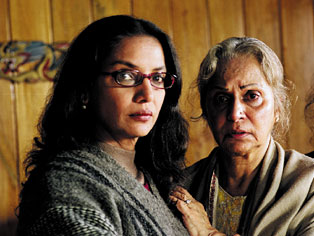Mohandas Gandhi had a harsh rejoinder to Katherine Mayo's notorious
Mother India, a book that had a huge impact on American and British views of India in the late 1920s:
Gandhi: This book is cleverly and powerfully written. The carefully chosen quotations give it the false appearance of a truthful book. But the impression it leaves on my mind, is that it is the report of a drain inspector sent out with the one purpose of opening and examining the drains of the country to be reported upon, or to give a graphic description of the stench exuded by the opened drains. If Miss. Mayo had confessed that she had come to India merely to open out and examine the drains of India, there would perhaps be little to complain about her compilation. But she declared her abominable and patently wrong conclusion with a certain amount of triumph: 'the drains are India'
For years I essentially bought Gandhi's take on the book, and didn't bother to read the infamous 'drain inspector's report'. It isn't hard to imagine what a polemical critique of the Indian practice of child marriage (which remained on the books until after independence), the mistreatment of widows, and hygiene might look like -- why bother?
But I've been surprised by the book itself, problematic as it undoubtedly is. And the story behind is more interesting than Gandhi probably knew. I taught part of it this week in my 'travel writers' course, and below is some of what I learned about Katherine Mayo in the process. Most of the background information below comes from Mrinalini Sinha, who edited a volume of
Selections from Mother India (Michigan, 2000). Sinha's long preface, from which I derive most of the following information, is one I would recommend for anyone interested in the
often vexed relationship between Western feminism and anti-colonial nationalism. Mayo was originally from Ridgeway, Pennsylvania, and had earlier written several books celebrating, of all things, the state's rural police force. Her politics were conservative in the American sense of the time: she was hostile to immigrants, blacks, and Catholics. Even that first book was criticized for portraying an oversimplified view of the Pennsylvania police force, though it obviously also opened doors for her socially and politically. Importantly, Mayo was a supporter of the
Asian Exclusion Acts, which were passed beginning in the late 19th century. These were American laws sharply restricting immigration from Asia and Africa. The laws were essentially racist in nature: the government wanted to encourage white European immigrants, and discourage darker-skinned people. Some Asians who had been born in the U.S. had their citizenship stripped from them at this time.
* * * * *
Katherine Mayo commits one act of outright deception in the opening pages of the book. In the foreword, she states that she is traveling through India and recording her observations without any assistance from any government agency:
For this reason the manuscript of this book has not been submitted to any member of the Government of India, nor to any Briton or Indian connected with official life. It has, however, been reviewed by certain public health officials of international eminence who are familiar with the Indian field.
And she says it again at the beginning of Chapter 1:
It was dissatisfaction with this status that sent me to India, to see what a volunteer unsubsidized, uncommitted, and unattached, could observe of common things in human life.
But the claim to autonomy wasn't true; according to Mrinalini Sinha, Mayo had been in direct contact with the British administration -- in fact, with
Central Intelligence Division in India (the officer she was in contact with is named in her letters – J. H. Adams). They had encouraged her to write a book critical of Indian habits and traditional Indian practices, partly as a rejoinder to Gandhi, who was making major strides in building a mass movement to end British rule. The Central Intelligence Division set up meetings with important people for her, and basically paved the way for her to do the exact research that would best support their claim that their rule over India was a benefit to the Indians themselves.
Because of the British role, we can say that Mother India is, quite literally, a work of Imperial propaganda. In light of the effect it had on readers in England, the U.S., and India itself, it was remarkably successful, though it was roundly criticized by the Indians themselves, who would, as everyone knows, continue to agitate for independence through the 1920s and 30s.
While it is essential to always keep in mind that Mayo wrote this book to support the British colonial authority, one needs to keep in mind that nothing about her official contacts was known at the time. The outrage
Mother India provoked amongst Indians, and even among some British and American readers, was all based on the assumption that her assessment was sincere -- if slanted.
* * * * *
What I've been surprised by on reading the actual text of Mayo's book is how many of her statistics on things like child marriage, infant mortality, and venereal disease come directly out of official documents and census reports. And her quotes about the public child marriage debate in 1925 (which involved many Indian politicians) are all a matter of public record: many prominent Hindus did support child marriage. She quotes people like Amar Nath Dutt, who is on record in the
Legislative Assembly Debates of 1925 as saying the following:
We have no right to thrust our advanced views upon our less advanced countrymen. Our villages are torn with factions. If the age of consent is raised to 13, rightly or wrongly we will find that there will be inquisitions by the police at the instance of membersof an opposite faction in the village and people will be put to disgrace and trouble . . . I would ask [Government] . . . to withdraw the Bill at once. Coming as I do, Sir, from Bengal, I know what is the opinion of the majority of the people there.
And Mayo has several others making statements along these lines (which bear somewhat of a resemblance to more recent debates over things like the Uniform Civil Code, I would argue).
Of course, quite a number of political reformers and Indian nationalists strongly opposed child marriage, even suggesting earlier reform bills that the British themselves had voted down. As Sinha points out, Mayo doesn't refer to them much if at all. She does, however, mention Gandhi's many condemnations of various kinds of social backwardness, on not just child marriage but also the treatment of widows as well as untouchability. She
loves Gandhi, who (unwittingly, of course) gives her ample material by which to tear apart the flaws in Indian society.
Alongside the true observations, there of course are many statements Mayo makes in the book that are either gross exaggerations or outright falsehoods. She piles it on so thick that she almost undoes her own argument about the evils of "Hindu tradition." If morals are in fact so debased, if hygiene is so bad, if girls are so mistreated -- how is it that the Indian population continued to grow at a healthy rate?
On the one hand, Mayo's book can hardly be seen as credible, both because of her involvement with British authorities and because of her errors and exaggerations on points of substance. On the other hand, many of her points are valid, which puts Indian nationalists and Euro-American liberals in an awkward position. We see versions of this still today, in the ongoing debates about "global patriarchy," especially in the recent push by Western feminists against the repression of Muslim women by Muslim men.
(Mayo's book is exactly the kind of thing Spivak is talking about in her various critical engagements with Western feminism, in essays like "Three Women's Texts and a Critique of Imperialism." It's odd that, as far as I know, Spivak never mentions Mayo, emphasizing instead writers who had connections to Empire that were in fact quite arguable -- like Mary Shelley and Charlotte Bronte).
More than fifty books and pamphlets were published in response to Mayo's book. It also led to a Broadway play and almost made it to the movies. Here are some of the titles Sinha lists:
Father India (1927);
Sister India (1928);
My Mother India (1930);
A Son of Mother India Answers (1928);
Long Live India: What a Son Has to Say About Mother and Father India (1932);
An Englishman Defends Mother India (1932); The Truth About Mother India (1928);
Unhappy India (1928);
Mother India By Those Who Know Her Better than Miss. K. Mayo (1927);
Miss Mayo’s Cruelty to Mother India (no date);
Mother India Ka Jawab (The Reply to Mother India) (1928). (The list goes on.)
One of the most important replies to
Mother India was by
Muthulakshmi Reddi, the first Indian woman legislator. Her reply was, Sinha suggests, probably not published, though it was delivered as a speech in Madras, organized by the Women's Indian Association. Reddi responds to a number of Mayo's arguments, but let's just focus specifically on the question of child marriage:
Reddi: Reformers of to-day do not deny there is the system of early marriage prevalent among the high cast Hindus with all its attendant evils, but Miss Mayo--to be true to facts--instead of condemning the whole nation might have added that it exists only among a certain section of Hindus and a large section of the Non-Brahmins and untouchables are not affected by it. Again for the evils of early marriage she goes for a list which was drawn up some 33 years back by the women surgeons of this country when a bill for raising the age of consent was brought by one of our Hindu brethren in the Assembly. Again in 1925 when the question for further raising the age of consent came before the Assembly there were speakers both for and against such a measure--those for said there was no text in Hindu religion to sanction early marriage and those against affirmed that religion was in danger. Even at that period, the countless women's associations through India held meetings and asked for reform.
Reddi has to concede that Mayo's arguments are based on reality, but only a partial reality. On the specific question of which castes practiced, I'm not actually sure whether Reddi claims that it was limited to Brahmins or Mayo's claims that it was universal is correct. But Reddi makes a good point that Mayo overlooks the broad opposition to child marriage that was felt by Indian reformers.

